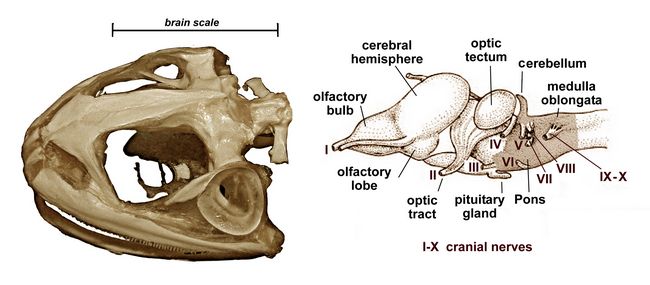Athena Review Image Archive ™
Frog skull and brain

Skull and brain of a Green Frog (Rana Clamitans)
The frog brain has an complex olfactory system, comprised of a large olfactory bulb and an accessory olfactory lobe. The cerebellum and visual lobe vary in size depending on whether the frog lives in trees or on the ground, with the tree-living frogs having larger lobes, in both cases.
Muscular
coordination and posture are controlled by the cerebellum, while the
medulla oblongata regulates respiration, digestion and other automatic
functions. Like fish, frogs and other amphibians have ten pairs of
cranial nerves By contrast, all amniotes (mammals, birds and
reptiles) have twelve pairs of cranial nerves.
Frogs
have binocular vision over a field of 100° to the front and a total
visual field of almost 360°. The eyes may be the only part of an
otherwise submerged frog to protrude from the water. The distant
vision of a frog is better than its near vision. recent research
has shown that frogs can see in colour, even in very low light.
Frogs
can hear both in the air and below water. The eardrums (tympanic
membranes) are directly exposed or may be covered by a layer of skin
and are visible as a circular area just behind the eye. Males have
tympani that are larger than their eyes while in females, the eyes and
tympani are much the same size.
References:
D
Copyright © 1996-2020 Rust Family Foundation (All Rights Reserved).